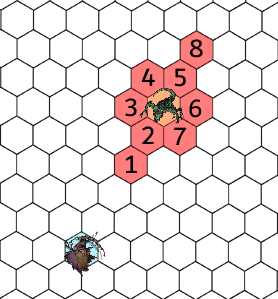Enchanted Realms Rulebook
Range Factors
Cover
Cover is a physical barrier which can play a factor against ranged attacks by directly aiding the target's Defense. There are two variations of cover: partial and full cover.
A target with partial cover gains +3 to his or her Defense as well as the same bonus for Agility saves against area of effect attacks; other sub-attribute saves gain no bonus. The protection used must cover at least half of one’s body, such as a low wall, a piece of furniture, the corner of a building, a tree trunk, or being behind a portcullis. Due to the target being smaller than normal or only occasionally available, by default if there are others in the vicinity, then the rule of friendly fire happens by default when firing at a target with three-quarters cover.
Finally, full cover protects the target from being aimed upon from range attacks, making the target effectively immune from range attacks. This also means magical range spells which rely on line of sight have no viable target. However, spells that attack the area can be used against a target with complete cover; a fireball would be an example. In such a case, a +5 bonus to Agility saves is granted to the target with full cover. Further, a someone protected by full cover may not take an action involving the direction from which the complete cover protects. An example would be a character behind a corner, could drink a potion but not look back around the corner to return fire. Despite the target in full cover being unable to be struck by standard range, should someone fire upon that target anyway, the friendly fire rule would be used.
Obscurement
The difference between obscurement and cover is where the modifier is placed. Cover grant a bonus to Defense for the target, but obscurement places a penalty on the character taking an action. The action is usually an attack, but in some cases it could be a penalty for another feat, such as an Awareness check. Many spells, fog of war for example, have the penalties in the description. However, lighting conditions might be ruled by the GM as a “minus X penalty” for attacks.
Friendly Fire
Firing at range into an area where other targets might be struck instead is the definition of friendly fire. Despite the minor misnomer of the term, the rule of friendly fire permits striking unintended opponents and neutral parties as well as allies. A blind shot, when a target in known to be in an obscured area but exact visual confirmation is not possible, would be one example of when the friendly fire rule would be used. Other circumstances might include cover, a blind effect on an archer, or fighting an invisible creature.

When friendly fire is used, then the normal modifiers for the condition (blind, invisible, cover, etc) are calculated into the shot; pay close attention to the penalties. If the attack is a miss, then there is a chance other targets (friendly, neutral or hostile) might be struck instead. The GM will determine the hexes that could be potentially hit. This will be all adjacent hexes surrounding the original target, as well as the hex 10-feet in front and behind the target in direct line of sight. The GM will then count all the other potential targets, assigning them numbers 1 through 8, then add two additional “empty” slots. A random roll on a d10 will be made to determine what other might be “hit.” The empty targets (9, 10 and unoccupied hexes) indicate the shot hit nothing. However, if another creature is in the allotted space rolled, then the GM compares the same score used against the original target, then gives a friendly fire adjustment which rolls the raw die scores forward by 2 points. The new values are checked against the new accidental target’s Defense. It is important to understand “adjust the dice forward” instead of just using a modifier because this means an 18 or 19 on the dice will become a “natural 20” against the alternate target. Also “natural 1” would become a “raw 3.” Thus, friendly fire targets do not have an automatic miss option, but has three chances for an automatic hit.
Lastly, it is important to remember what an attack indicates with range. Unless under an effect or using a skill to “split the dice” then multiple d20s are still firing only a single attack. Thus, all attacks would have to miss the target when firing blind to have a chance to hit an alternate target. However, if this occurs, all the d10s are rolled forward for the comparison and are used against only one new alternate target. If the dice are “split” for any reason, then each target uses the same rule with the set number of dice, which means more than one alternate target could be harmed.